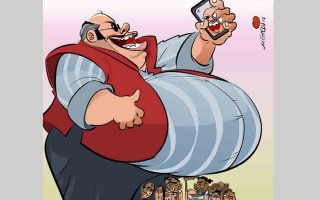Income inequality goes off track
A major election pledge of the successive governments led by the Awami League to eliminate income inequality has gone off track as the poor are deprived of the high economic growth because of skewed policy helping the rich to become richer.
Economists said that the affluent people maintaining links with the ruling party grabbed the larger pie of the steady and average 6 per cent economic growth obtained over the past one decade because of the widening income disparity that also caused widespread distortions in all spheres of society from consumption to politics and state-facilities to asset-accumulation.
The high economic growth was attributed largely to farmers who ensured food security, workers of the export oriented readymade garment sector, expatriates sending millions of dollars from foreign soil and middle class helping the service sector to expand.
The persisting unequal distribution of wealth has, however, not only prevented them to get their due benefits from the gain but also taken away the gloss of the growth in gross domestic product surpassed 7 per cent first time in financial year 2016-17, noted the economists.
‘Elimination of Poverty and Inequity’ was a major the election pledge the AL made in the general election in 2008.
In the 2014 general election, boycotted by all opposition parties including the Bangladesh Nationalist Party, the AL in its electoral manifesto said that economic policies pursued by it from 2009 would be followed for improving the standard of life.
Referring to the findings of the Household Income and Expenditure Survey released by Bangladesh Bureau of Statistics in 2016, former Dhaka University economics department chief MA Taslim said that the Awami League failed to implement its most crucial electoral pledge.
He noted that average income of people decreased by 2 per cent in 2015 compared to 2010 and the real spending for consumption of each household decreased by 1 per cent.
Besides, the Household Income and Expenditure Survey demonstrates opposite scenario what the AL pledged on income disparity as the Gini co-efficient, used to measure income inequality, increased to 0.483 at national level in 2016 from 0.458 in 2010.
This meant that the rich became richer while the poor poorer during the period, said MA Taslim.
The top 10 per cent households of Bangladesh held 38.16 per cent of national income in 2016, up from 35.84 per cent in 2010 while only 1.01 per cent of the income went to the bottom 10 per cent households in 2016 against 2 per cent in 2010, said the survey report.
Many of these wealthy people are allegedly not investing in the country but smuggling out accumulated wealth to foreign countries, including Malaysia, where a total of 3,746 Bangladeshis availed the investment opportunity until August 2017 and held the third place behind China and Japan in the programme.
Citizens of Bangladesh required investment ranging from 10,000 to 300,000 Malaysian Ringgit, equivalent to about Tk 2.42-72.82 lakh, to avail the second home tickets.
The Awami League policymakers, however, said that income inequality was not surprising in an economy with high growth like Bangladesh, but should be checked before crossing the danger level of 5 per cent.
Finance minister AMA Muhith said that income inequality had gone up, but one should also focus on the positive aspects, including falling rate of extreme poverty.
Despite the high economic growth poverty reduction, which takes priority over streamlining income distribution, slowed to 1.2 per cent a year in 2010-16 compared to 1.7 per cent a year in the preceding five years.
Besides, the unequal distribution of wealth also contributes to internal migration as about 63 per cent of the total growth of Dhaka’s population is caused by migration and only 37 per cent growth comes from natural increase.
According to World Bank, 3-4 lakh people migrate to Dhaka each year.
General Economics Division member Shamsul Alam said that they had already taken measures to increase income of the poor by providing higher allowances from the national budget.
Besides, implementation of the infrastructural projects like Padma Multipurpose Bridge and proposed higher expenditure on education would help checking the income inequality, he said.
It would take some years to see positive impacts, he added.
Dhaka University economics teacher Selim Raihan, also the South Asian Network on Economic Modelling executive director, said that it was difficult to become optimistic against the backdrop of heterogeneous economic indicators.
Pointing to disclosures recently made by a United States-based research firm that ranked Bangladesh the fastest growing country with an increasing number of ultra rich in the world, he said that only few people including those linked with the ruling party were benefitted from the skewed economic growth.
On September 5, WEALTH-X of the United States said that the ultra high net worth population in Bangladesh was growing at the rate of 17.3 per cent over the five years from 2012 to 2017 and ahead of China (13.4 per cent) Vietnam (12.7 per cent), Kenya (11.7 per cent), India (10.7 per cent), Hong Kong (9.3 per cent), Ireland (9.1 per cent), Israel (8.6 per cent), Pakistan (8.4 per cent) and the United States (8.1 per cent) in the ranking.
Another US firm Global Financial Integrity in its report released on May 1, 2017, said that illicit capital flight from Bangladesh was on the rise from 2007 and continued until 2013 when the highest $9.66 billion was siphoned off.
News Courtesy: www.newagebd.net











